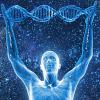.
S O U R C E : Josh Mitteldorf's blog 'Aging Matters'
naxleo posted original bioRXv's source yesterday at Longecity (Reversing age: dual species measurement of epigenetic age with a single clock)
If you eschew hyperbole and hang in for the long haul, maintaining a discipline of understatement in the midst of a flashy neon world, you may be offered a modicum of credence when you make an extraordinary announcement. No one is entitled to this courtesy twice. If the news that you trumpet to the moon does not pan out, your readers will be justified in discounting everything you say thereafter.
Here goes.
I believe major rejuvenation has been achieved in a mammal, using a relatively benign intervention that shows promise of scaling up to humans. I’m going to stake my reputation on it.
Cartoon by Maddy Ballard
In the race to effect substantial, system-wide rejuvenation, Harold Katcher is a dark horse. He has the right academic credentials and a solid history of research. In fact, in earlier life he was part of a team that discovered the breast cancer gene, brca1. I asked Harold for a biographical sketch, and have printed it in a box at the end of this posting.
But Katcher has no research grants or university lab or venture capital funding, no team of grad students mining databases and screening chemicals in the back room.
One thing Katcher has going for him is the correct theory. Most of the explosion in aging research (and virtually all the venture capital startups) are looking to treat aging at the cellular level. Their paradigm is that aging is an accumulation of molecular damage, and they see their job as engineering of appropriate repair mechanisms.
The truth, as Katcher understands it, is that, to a large extent, aging is coordinated system-wide via signal molecules in the blood. It was our common realization of this vision that brought Katcher and me together more than a decade ago. Katcher briefly describes his 2009 epiphany below. It was the source of his 2013 essay (it took a few years to get it into print) on the significance of parabiosis experiments for the future of aging science.
Of course, Katcher was not the only one to get the message about the power of signal molecules in the blood to reprogram tissues to a younger state throughout the body. The problem is that there are thousands of constituents represented in tiny concentrations in blood plasma, but conveying messages that cells read. Which of these are responsible for aging? A small number of labs, including the Conboys at Berkeley, Amy Wager at Harvard, and Tony Wyss-Coray at Stanford have been searching for the answer over the last decade and more.
Katcher has been able to guess or intuit or experimentally determine the answer to this question. With seed funding from Akshay Sanghavi, he set up a lab in Bangalore two years ago, and tried to rejuvenate old lab rats, using a fraction extracted from the blood of younger rats. The first round of experiments were encouraging, published in this space a year ago. He obtained the next round of funding from a reader of this blog, and had enough rats to titrate dosages experimentally, and to see if treated rats who aged again over time could be re-treated successfully.
There is a hole in this story that awaits the resolution of intellectual property rights. Katcher and Sanghvi have not applied for patents and have not yet found a suitable partner to provide financing for human trials. They have not revealed any details of the treatment, besides the fact that it is in four intravenous doses, and that it is derived from a fraction of blood plasma. Katcher thinks that the molecules involved will not be difficult to manufacture, so that when a product is eventually commercialized, it will not require extraction from the blood of live subjects, rodent or human.
We’re still waiting for longevity curves of these treated rats. In the meantime, the best available surrogate measure of age comes from methylation clocks, as developed by Steve Horvath at UCLA, and other scientists as well. Crucially, Katcher found an ally in Horvath, who didn’t just test his rejuvenated rats, but did the needed statistical analysis to develop a set of six methylation clocks specialized to rats. FIve of the clocks are optimized for different tissues, and one is calibrated across species, so that it can measure age in humans as well as corresponding age in “rat years” (about 1/40 human year). The two-species clock was a significant innovation, a first bridge for translating results from an animal model into their probable equivalent in humans.
In a paper posted to BioRxiv on Friday, Katcher and Horvath report results of the methylation measurements in rejuvenated rats. “Crucially, plasma treatment of the old rats [109 weeks] reduced the epigenetic ages of blood, liver and heart by a very large and significant margin, to levels that are comparable with the young rats [30 weeks]….According to the final version of the epigenetic clocks, the average rejuvenation across four tissues was 54.2%. In other words, the treatment more than halved the epigenetic age.”
Human-rat clock measure of relative age defined as age/maximum species lifespan.
Besides the methylation clock, the paper presents evidence of rejuvenation by many other measures. For example:
- IL-6, a marker of inflammation, was restored to low youthful levels
- Glutathione (GSH), superoxide dismutase (SOD), and other anti-oxidants were restored to youthful levels
- In tests of cognitive function (Barnes maze), treated rats scored better than old rats, but not as well as young rats.
- Blood triglycerides were brought down to youthful levels
- HDL cholesterol rose to youthful levels
- Blood glucose fell toward youthful levels
A major question in blood plasma rejuvenation experiments has been how often the cure must be administered. Many of the components of blood plasma are short-lived, secreted into the blood and absorbed continuously throughout the day. The good news from Katcher’s results is that it seems only four injections are needed in order to achieve rejuvenation.
.../...
.
Edited by Engadin, 11 May 2020 - 10:11 AM.





































































